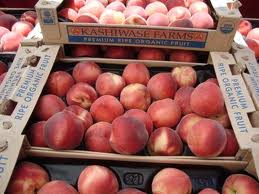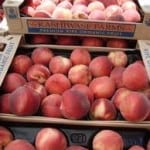
 What brings you to the Farmers Market? Great food, great principles and values, or great community?
What brings you to the Farmers Market? Great food, great principles and values, or great community?
This weekend, I was listening to environmentalist and author Bill McKibben being interviewed by Public Media’s Krista Tippett on the radio program “Speaking of Faith.” McKibben is the founder of 350.org, an organization leading the fight to bring the level of carbon in our atmosphere – currently an alarming 390 (compared to the 280’s back in the 1950’s) – back to a ration of 350 or lower.
Interviewer Tippett brought up the current trend towards increased emphasis on local foods and farmers markets. McKibben commented it takes “a lot less energy to move a tomato five miles than 5000 miles, and, not coincidentally, it tastes better, too.”
I started nodding in agreement. McKibben went on, “but the real reason that’s so interesting that we like farmers markets, I think, turns out to be that they are different.” I did a small double take.
Not great tasting food; not shared ecological, environmental and nutritional values; but different. Different? From what?
From the supermarket shopping experience, McKibben clarified. He mentioned sociologists’ comparison of shoppers’ behavior in supermarkets and in farmers markets. On average, farmers market shoppers had ten times as many conversations per visit than supermarket shoppers. Because of our current lifestyle, McKibben said, we have become “the first species who’ve had no practical need for neighbors for anything.” Large, artificially lit supermarkets have only become commonplace during the last 50 years or so, and 80% of the world still shops for food in the traditional local market way. McKibben says that strolling in a marketplace and interacting with others while shopping feels good because it is what we’re “built for.”
So, what draws you to the Culver City Farmers Market each Tuesday afternoon? I know my experience is enhanced by talking with farmers and vendors; running into friends and neighbors and catching up with them while listening to some of the great street musicians who’ve graced our market; and, on occasion, making plans to meet someone at the market, shop together and enjoy an al fresco dinner together purchased from one of the stands.
I was buying some absolutely wonderful peaches the other week when I noticed a young man wearing a chef’s uniform asking the vendor the price per crate. I asked him if he was a chef for one of the great downtown Culver City restaurants. John (he gave me his first name only) was a private chef. The peaches were to be used in making a vodka-based peach schnapps.
I was intrigued. My friends Ian and Margot make a cranberry-infused vodka with a kick of chili pepper in it for Christmas gifts, and my friend Beth has told me how she made vanilla-bean infused rum for holiday presents. But capturing the essence of summer in a drink or cocktail made with an infusion from freshly picked organic peaches? Mmmmmmm. John kindly told me his technique for making peach vodka. Great food? Check. Local food? Check. Community and human interaction? Most definitely check.
The summer’s heat has been playing hide and seek with us for the last 6-8 weeks, it seems. Every time I’m about to share one of the most refreshing summer drinks I’ve ever had, the weather turns cold. A request from reader Elizabeth for recipes featuring the wonderful melons at the market gives me the chance to share a cantaloupe juice recipe I was first introduced to by a coworker in the mid-Wilshire area. Filipino in origin, it is the perfect antidote to summer heat. Another refreshing, cooling adult beverage – perfect for designated drivers and calorie counters – is chilled ice water with a few cucumber slices in it. Read below for recipes and instructions.
Peach Vodka (schnapps)
Ingredients for one liter:
1 liter vodka (use medium-priced vodka for this; premium vodka would be fine, if expensive, but cheap vodka often has sharp flavors that would interfer with the taste of the fruit infusion)
3-4 well scrubbed skinned, thinly sliced peaches (you’ll want ones which are just beginning to yield to pressure from your fingers or thumb … the fruit will continue to ripen while infusing)
a clean jar with an airtight sealing lid (a sun tea jar works fine; avoid old pickle jars unless you’re looking forward to drinking dilled peach vodka – any recycled jar should be thoroughly washed so your infustion doesn’t pick up odors or residue)
Directions:
Fill the container. The fruit should submerged or covered with the vodka. Seal the container and put it in a safe place away from direct sunlight. Shake it gently every couple of days. Make a visual check of the fruit. If it is overripe or starting to brown, remove it and replace it with fresh fruit. Otherwise, the liquor will take on the flavor of the overripe fruit. If you’re making one liter, it should be ready in 4-7 days. If you’ve increased the quantity, it may take 1-2 weeks to infuse. When done, strain the infused vodka into clean bottles through a strainer lined with cheese cloth or a coffee filter. The schnapps is sometimes better after aging for 2-4 weeks. Enjoy! (Responsibly, of course.)
Cantaloupe Drink
one medium to large cantaloupe will make four servings
Ingredients:
1 fragrant, ripe heavy cantaloupe
sugar syrup to taste
cold water
ice for serving
wide mouthed glasses
spoons
optional: squeeze of fresh lemon juice
You’ll need a melon shredder, available in Asian markets. You could use a fork if you don’t have a melon shredder. Wash the cantaloupe carefully, and cut it in half with a clean knife. Scoop out the seeds and membrane. Working over a large bowl to catch the juices as they run, gently shred the cantaloupe flesh into shreds. They will look like they are julienned. Avoid shredding the cantaloupe all the way down to the rind; the paler parts have a slightly bitter taste.
Taste the juice to determine how sweet it is. Usually you will want to add some sugar syrup to enhance its sweetness. It’s easy to make sugar syrup. Combine equal parts of sugar and water and cook over low to medium heat for 3 or 4 minutes. Do not bring to boil. Take off heat and let cool. Add sugar syrup to the cantaloupe juice and shreds until it is sweetened to taste. You won’t need much if you’re using one of the wonderful farmers market melons; supermarket melons might need an extra boost. Some people enjoy a squeeze of fresh lemon juice to balance the sweetness.
Slowly add cold water until the mixture is at least half liquid and half solid. Add ice if you are serving right away. You can refrigerate the cantaloupe juice for several hours up to a day before serving. The juice should be covered for longer term chilling to avoid picking up other refrigerator flavors.
Cucumber-flavored water
You may have enjoyed this at a spa or at your local Koo-Koo-A-Roo. An unusual-sounding combination to those of us who grew up on middle-America’s meat and potatoes, cucumber slices in water are, in fact, wonderfully refreshing. Like all simple recipes, it is amenable to inspired improvisations.
Ingredients
1 slicing cucumber; 2-3 pickling or lemon cucumbers; 1-2 large Japanese cucumbers or a portion of an Armenian cucumber
ice water
optional: lemon, lime, mint, …
The fun thing about shopping at the Farmers Market for your cucumber(s) is the wide variety available for you to choose from. If you are using a slicing (the most common supermarket cucumber) or Japanese cucumber, you may want to experiment by adding lemon or lime slices or sprigs of fresh mint. The subtle flavor lemon cucumbers and the delicacy of pickling or Armenian cucumbers is best enjoyed unenhanced first. After you’ve tried them alone, you could then move on to adding a little mint with the Armenian and pickling cucumbers and a slice or two of lemon with the lemon cucumbers. It is always a matter of what tastes good to you.
Make sure your cucumber is well-washed. Using a clean knife, slice it crosswise into _ – _ inch slices. Place the slices in a pitcher, add cold water, and refrigerate for at least one hour. If you choose to add citrus slices or mint, add them when you add the cucumber.
The Culver City Farmers Market is held each Tuesday from 2 to 7 pm on Main Street between Venice and Culver Boulevards.
Katie Malich gets by with a little help from her friends, new and old, who share their favorite recipes and tips at the market.
Speaking of Faith is broadcast locally on KPCC 89.3 FM. The quotations are from the August 5, 2010 show. Listen to the entire interview of Bill McKibben by host Krista Tippett in “The Moral Math of Climate Change” on line or via podcast at Speakingoffaith.publicradio.org.




Be the first to comment